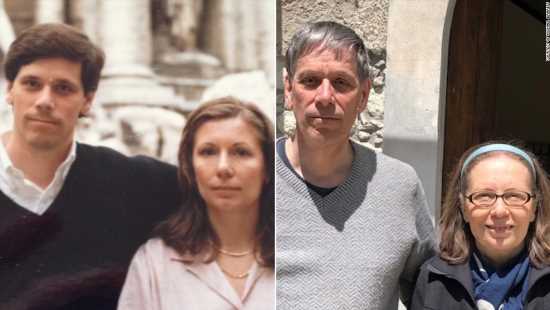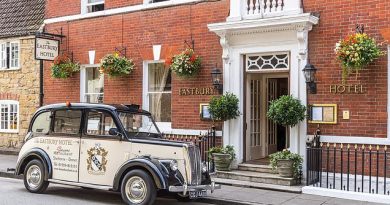The Americans who bought a house in Italy online
How many of us have been sitting at home, seen a dreamy picture of a foreign country, and started planning our life there?
That’d be a lot. But how many of us have actually gone ahead, bought a property and planned that future life — without setting foot in the location?
Michael Barrett may just be a first.
The Chicago native spent much of last year’s lockdown drooling over homes for sale in Italy. But instead of being content with drooling, he and wife Aida went one step further — and bought a house, sight unseen.
And, he says, buying a property remotely was far more sensible than doing what many non-Italians do — come on vacation, fall in love, visit a handful of places, and make an offer.
In fact, he reckons, this could be the way forward in a post-pandemic world.
It sounds like a horror story. Sixty-something American couple buy house abroad without seeing it, without having met the seller, the agent, the architect or even the internet friend who signed on the dotted line for them.
But the Barretts are convinced this was the smartest thing they could do.
Load Error
Decisions, decisions
First things first. Michael and Aida Barrett may live in Wisconsin, but they aren’t Italy newbies.
Aida is from Calabria — the couple met when she came on vacation to Chicago 35 years ago. Ever since their wedding, they’ve made regular visits across the pond — she going home every year for a couple of months; he joining her for two or three weeks, every other year.
They spend half their time at her family’s villa in Calabria, and half exploring the rest of Italy.
That’s how Michael Barrett fell for the country. Aida “opened my frontiers,” he says. He grew to be deeply in love with Italy — but the real Italy, not the one foreigners tend to fantasize about. They decided that when they retired, it had to be there.
“I’m maybe a little bit more enthusiastic about uprooting ourselves than my wife,” he says. “She knows every detail of Italian culture — she’s from Amantea [Calabria] and has a degree in Italian history and literature. But I was the one saying every couple weeks, ‘Let’s go to Italy.’ I love every detail of the place, I really do. I’ve been dreaming about moving forever.”
The Barretts agreed that they’d see out their retirement in Italy — but they also knew that things in Italy take time.
“You have to be very patient doing anything in Italy, and we didn’t want to be in a B&B for two years while our house was renovated,” says Michael Barrett. “We were happy to uproot ourselves, but not without reestablishing new roots. Being nomads isn’t a great option at our age.”
Decision one: taken. They wanted to buy a few years before retirement, to have their dream home ready to move in to on day one. It was late 2019 at this point, and they decided that 2020 would be the time to buy.
Decision two: where to buy. That one was a little harder.
The legendary $1 homes of southern Italy weren’t for the Barretts. For one thing, they’d require too much time and renovation. For another, they’d spent a lot of time in Amantea, and worked out that southern Italy was too remote from the major cities for them.
So they compiled a list of requirements. A very specific one, too.
“It had to be within two hours of a major city with advanced medical care and a large international airport,” says Barrett, who says they were looking for something “cheap and cheerful” rather than the statement properties American immigrants often seek out in Europe.
“We wanted to be near water, within walking distance. We also wanted to be within walking distance of a train station and market so that we could have the option of being car-free.
“The property needed to be fit for habitation — no derelict one euro deals for us. Three bedrooms and two or more bathrooms.”
Oh, and they didn’t want to be near other Americans.
“When I see a bunch of American tourists, I want to go someplace else,” says Barrett. “I feel like I’m in Disneyland.
“Whenever I’m in Italy, I want to be as Italian as I can possibly be. Picking oranges off the tree, riding my bike around the countryside, cooking meals in the kitchen, striking up conversation with random people in my terrible Italian. I like to be transported to a completely different culture.”
Finding the right location
So with expat-heavy locations such as Tuscany ruled out, in January 2020, they started surfing the internet, looking for places that might fit the bill — and where they could find something in their price range of €75,000-€200,000 ($88,000-$236,000).
They started making plans to fly to Italy in April or May 2020, hoping to have put together a shortlist for viewing by then.
But with their daughter working in Brussels — for Pfizer, no less — it was clearer to them earlier than to many that the trip might not happen.
“Our home-buying plans were in jeopardy, but I was enjoying my online search activities,” says Barrett.
So the couple kept looking.
“We found a couple of properties that might have worked around the lakes on the Lazio-Tuscany border, but since we hadn’t been there, we couldn’t see ourselves as happy,” he says.
Instead, they started homing in on Italy’s northern lakes region, within spitting distance of Milan and its two international airports.
And although Como and the classic locations were well out of their budget, they couldn’t help noticing that the southern part of Lago Maggiore — west of Como, straddling the Swiss border — had properties that fit the bill.
It was little over an hour’s drive to Milan, half that to Malpensa airport — which could whisk them around Europe, as well as back home — and they had the Alps on the doorstep.
In fact, it reminded them of their current home, in Lake Geneva, Wisconsin — an easy drive to Chicago and O’Hare airport, but with a laidback, lakeside life where they could keep their boat on the water.
What’s more, where Como has a “congested waterfront” and steep hills behind it, Barrett says that Maggiore is less steep, which means more room to build.
“We quickly focused on Maggiore. We kept looking at other listings, but were returning to Maggiore week after week as it fit our requirements.”
There was just one issue: although they’d visited the lakes region before and been to Como, neither Michael nor Aida had ever been to Maggiore.
Buying a house virtually
So how does one go about buying a house in a place one’s never been to, during a global lockdown?
For the Barretts, it was simple — just involve a third party.
When their requests to on-the-ground real estate agents went unanswered, they made contact with realtor Sean Carlos, who’s based between Milan and Tuscany.
They told him their plan: that they would draw up a shortlist of properties, and he would go visit them and take them on virtual walk-throughs. For any that they were interested in, they’d commission an architect’s report. And if they wanted to buy, Carlos would be the lynchpin.
Where did they find him? On a Facebook group. Perhaps that makes you feel queasy, but the Barretts are matter-of-fact about it.
“When I spoke to him I realized it wasn’t just me interviewing him, he was interviewing me, and that made me more comfortable,” says Michael Barrett.
“We talked about our family history — that my wife had graduated from Rome university, my daughter from Milan. He screened me to the same extent as I screened him, and I think if I’d come off as a novice, he’d have said no.”
Carlos confirms that.
“I do have to be careful with the people I work with, so I ask a lot of questions at the beginning to see where they are in their thought process, and if they’re just window-shopping,” he says.
“The fact that Michael’s wife was Italian, and he’s spent a significant amount of time in Italy meant they were much higher on the knowledge curve than a lot of foreigners who’ve maybe vacationed here a couple of times.”
So he agreed to take them on as his first ever remote buyers.
Of course, they didn’t realize just how remote it would be at that point — the Barretts thought their daughter could fly down from Belgium to sign for it. But that wasn’t to be.
‘Like making an Airbnb reservation’
From March to May last year, Michael and Aida were scouring the internet for potential homes.
“Deciding on locations was almost exactly the same process we had used while taking our Italian vacations — we would check the local amenities and look at transportation and climate, and look to see what local life would be like, including shopping opportunities,” says Barrett.
They set up a chain — they would find listings of potential homes, and pass them on to Carlos, who’d do his own research.
“If the property had merit, he would contact the local seller’s agent and get additional information,” explains Barrett.
“Sean was very good at filling in the blanks in terms of having a complete virtual process. Transatlantic home shopping became a process similar to making an Airbnb reservation, only the stakes were much higher.”
Barrett, a product manager who makes international sales in his day job, took the process in his stride.
Finally, they found a place that looked good. It was in Lesa, on the western, Piedmont side of Lake Maggiore — and even had a lake view from the top floor. But on a video tour with Carlos, it was clear that it was in a much worse state than the (old) listing photos had suggested. “I decided halfway through the video tour it was no good,” says Barrett.
So they moved on to the next. Five miles south from Lesa was Meina, another lakeside town. Here, a pretty shrub-topped stone arch led onto a track with lemon-painted houses either side — one of which was for sale.
It was a three-story house from the early 1900s: three bedrooms, three bathrooms. It opened onto a courtyard shared with nearby houses — offering both privacy and parking.
They quickly commissioned an architect’s report. It was in good condition, he wrote, and had been lived in until recently by an elderly couple — it just needed nipping and tucking, having last been renovated in the 1990s. A video tour confirmed: they might be nearly 5,000 miles away, but they liked it. They made an offer: €75,000 ($88,000). The owners counter offered: €85,000 ($100,000). They agreed.
“We purchased entirely on the information in the architect’s report,” admits Barrett.
“This may be less romantic than falling in love with a property while on vacation. However, it allows a highly qualified local professional to detail the property from a technical point of view. He not only evaluates details most homebuyers miss, but plans for future renovations.
“It made me almost anxious, it was so easy.”
Signing on the dotted line
So they’d found The One. Next up — how to complete the sale. It was July, and there was still no way the Barretts would be able to fly over from the US.
They agreed that their daughter would drive down from Brussels, inspect the house for her parents, and then sign the deeds, using a power of attorney. But by the time they’d navigated the long Italian summer holidays and an unresponsive notary, it was late October, and the second wave of the pandemic was gathering force in Italy. They scheduled for early November, and then canceled. The Barretts didn’t want to put their daughter at risk.
But they couldn’t buy the house without a proxy signing the deeds for them.
Enter the knight in shining armor — and a whole lot more trust.
A meeting of minds
Have you ever met someone on social media and become firm friends without ever having met?
It’s happened to many of us during the pandemic, and Michael Barrett is no different.
A keen cyclist — “I’m one of those guys who gets into lycra and onto his bike,” he says — he’s a member of various Facebook cycling groups, and back in summer 2020, he’d noticed some pictures of a bike ride around Lake Como, posted by a guy called Doug Ritter.
“I wondered, what’s an American doing in Italy right now? I was curious and frustrated — I love taking long bike rides on vacation — and I sent him a private message, saying, ‘I really enjoyed your post, you must be a resident,'” he says.
Cyclists, he reckons, understand each other. “You have to trust them — if they turn or stop quickly, all of you hit the pavement at 20mph.”
And so, after a few months chatting about Italy (Ritter lives in Milan) and cycling, he had a thought. What if Doug acted as their proxy?
They didn’t take it lightly. Although they were buying the property in cash, that cash was, says Barrett, “a large fraction of our retirement savings — the loss of the money or any real estate fraud would have been catastrophic.”
But from his experience so far, he trusted Carlos. And his cyclist’s intuition meant he trusted Ritter, too.
Also, he points out, he wasn’t transferring the money to either of them. It was going directly to the owners via the notary.
Another plus point? Ritter had bought two properties in northern Italy in the past three years. He knew what to look for — and what to look out for.
And that’s how the Barretts ended up asking a man they’d never met before to sign the deeds for a home they’d never seen, having been shown around it virtually by another complete stranger, with the whole process being overseen by the notary — who, again, they’d never met.
The moment of truth
December 2, the date set for the handover, there was a storm over Lake Maggiore. Ritter arrived to find the house had been hit by rain and snow. That, says Barrett, turned out to be a plus point — it meant that if there’d been a problem with leakage, it’d have shown up.
“I asked him to walk through the place an hour beforehand, and said, if you think it’s a disaster, you don’t even have to explain why — just walk away,” says Barrett.
“Making a setback financially was not on the cards — I’d have trusted him if he’d said there were too many things wrong.”
In fact, Ritter and his Italian fiancée thought it was great.
“They said it’s a good starting point — that it was a charming house, needs work, but it was watertight and weathertight. And they said the town was fabulous.”
They — or, rather, Ritter — signed the dotted line.
There is work to be done on the property. The Barretts are working with architect Emanuele Monti, who produced the initial report, to remove one of the three bathrooms and all-round upgrade the house, adding insulation and rewiring it, and then redecorating.
But using Italy’s economy-rebooting “superbonus” scheme, they can claim tax breaks on the work, so they’ll end up spending €22,000 ($26,000) to receive €97,000 ($114,000) worth of work.
“Now we’re feeling smart,” says Barrett.
They think the works will take a while to complete, but they hope that they can swiftly make one of the three levels habitable so they can stay there before too long.
Worst case scenario
It has been nearly four months since Michael and Aida Barrett bought the house in which they’re planning to spend their retirement. And they still haven’t seen it. They’re hoping to get there once they’ve been vaccinated and travel restrictions have relaxed.
So what if, when they get there, they don’t like it?
Turns out, they’ve discussed that.
“The worst case scenario is that we don’t like it,” says Michael Barrett.
“Then what would we do? Well, we’d have a place to live in while we search for an alternative, which is nice. And then we’d rent it — I think it’d rent pretty easily, so there is a plan B if we don’t like it.”
Of course, they’re hoping plan A — to live in it for ever more — will prevail.
“We’re 90% sure it’s the right one, only because our expectations are quite modest,” he says.
“In this price range normally you’d find something with one or two bedrooms, or concrete architecture, so our choice was something newer but much more austere.
“We knew that was the alternative — not beautiful, and not really Italian. This is better, at the same price. We like the idea of the courtyard, the arch with the tree growing out of it.
“We could be wrong — but we think we’ve done it.”
Barrett — backed up by Sean Carlos, the realtor — says what they did isn’t for everyone. If you want to know how the light falls at a certain time of day, or want to feel the house, you’re not going to buy remotely. “I don’t think what we did replaces buying locally,” he says. What’s more, the Barretts were consulting a Milanese friend throughout the process — and of course Aida and their daughter speak fluent Italian.
Even so, he says he’d recommend a hybrid of what they did to everyone.
“I’d say 70% of the work is searching online anyway, and I’d recommend using a local architect — have a second pair of eyes, someone who’s local looking at it.
“Do your diligence upfront, and if you find something you really like, you can jump on a plane… to calm the nerves. But do that after you’ve searched online, the architect has done a report and you know what the climate and population is like.”
And while what they did is certainly clinical, he thinks it’s a better approach than the standard “fall-in-love-on-vacation-and-buy-on-the-spot” situation.
“I actually think it’s a disaster for an American on vacation to buy property,” he says.
“You don’t know what you’re looking at — you fall in love and buy it, and that’s a much more superficial decision than we made.”
Source: Read Full Article




